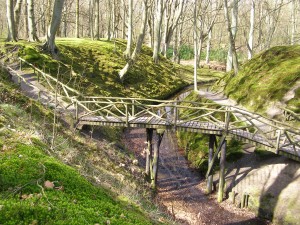This very weekend Staatsbosbeheer, its owner, will start an emergency felling of trees on the grounds of Elswout and neighbouring Duinvliet.  This is the result of an extensive review of the health of many trees on both estates. The survey was initiated by the unexpected collapse of an old tree in August 2011.
This is the result of an extensive review of the health of many trees on both estates. The survey was initiated by the unexpected collapse of an old tree in August 2011.
The current felling follows extensive restoration works carried out in Elswout over the past year, which mainly concerned its pavilions and bridges.
The work has started today, as the situation appears to be too critical to wait till after the holidays. First up will be trees along a public cycling path, on the grounds of Duinvliet. Staatsbosbeheer expects the investigation of potentially dangerous trees and -when necessary- felling of more trees will last through the first half of 2012.
Counting rings?
I just hope someone makes the effort to count growth rings on the older trees, as parts of nowadays Duinvliet are remnants of one of the oldest landscape gardens in The Netherlands: Sandenhoeff in Overveen. In my article on the subject I make a case for that claim, by pointing out that although we know very little of the actual layout of the garden at the time, the fact that plants from the New World are purchased for it as early as 1756, can only mean an attempt was made to create an English garden in the dunes west of Haarlem. 1H. van der Eijk, “Sandenhoeff: een vroeg landschappelijke tuin?”, Cascade 18 (2009), nr. 2, p104-110. He called them ‘Americaansche boomen’ and paid for the complete package of getting trees from the other side of the ocean: retrieval, freight, transport and -not the least- provision.
At the time, Dutch gardens were still laid out in a traditional manner, full blown landscape gardens did not appear till the 1780s. One of the first was Elswout itself, by the way, initiated by a member of the Boreel family.
In letters to his friend Jacob Boreel, Sandenhoeff’s owner Cornelis Backer exclaimed that he very much enjoyed the layout of those gardens, although he had admittedly never seen one for real. While Boreel was in Engeland during two tours on behalf of the Dutch government (1759/1760 and 1761-1762), he was constantly pressed by Backer to send home drawings and prints of gardens in England, as well as plants he had heard about. In the mean time Backer sent fruit from Boreel’s garden (Beeckestijn) and grapevines to England, in order that Boreel could entertain his guests during meals and have some gifts ready for people who he might want give one.
Let’s just hope that the current cutting of trees can confirm the early landscape layout I have discerned from Backers letters and cash register…
Footnotes
| ↑1 | H. van der Eijk, “Sandenhoeff: een vroeg landschappelijke tuin?”, Cascade 18 (2009), nr. 2, p104-110. He called them ‘Americaansche boomen’ and paid for the complete package of getting trees from the other side of the ocean: retrieval, freight, transport and -not the least- provision. At the time, Dutch gardens were still laid out in a traditional manner, full blown landscape gardens did not appear till the 1780s. One of the first was Elswout itself, by the way, initiated by a member of the Boreel family. |
|---|



A photo of one of the trees at Duinvliet can be found here: http://twitter.com/#!/BoswachterMark/status/150577668507697153/photo/1
And the beginning of the video of this local news broadcast (RTVNH) explains why the trees are cut down (in Dutch):
http://www.rtvnh.nl/nieuws/70909/Wandelen+in+bos+Elswout+levensgevaarlijk